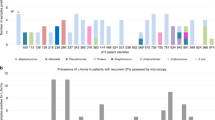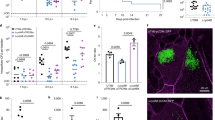Abstract
De novo synthesis of purines has been suggested to be an important factor for the pathogenesis of uropathogenic E. coli (UPEC). We analyzed the role of the redundant purine biosynthesis genes purN and purT, responsible for the third step in the purine biosynthesis, during UPEC infection. Growth experiments in M9 (minimal media), MOPS (rich media), filtered urine, and human serum with E. coli UTI89 and ΔpurN, ΔpurT, and ΔpurN/T mutants revealed that UPEC relies on de novo purine synthesis for growth in minimal medium. Mutants in individual genes as well as the double mutant grew equally well as the wild type in urine, rich media, and serum. However, during competition for growth in urine, the wild type UTI89 strain significantly outcompeted the purine auxotrophic ΔpurN/T mutant from late exponential growth phase. Inactivation of purN and/or purT significantly affected UPEC invasion of human bladder cells, but not the intracellular survival. Cytotoxicity levels to bladder cells were also diminished when both purN and purT were deleted, while single gene mutants did not differ from the wild type. When infecting human macrophages, no differences were observed between UTI89 and mutants in uptake, survival or cytotoxicity. Finally, the lack of the pur-gene(s), whether analysed as single or double gene knock-out, did not affect recovery rates after in vivo infection in a mouse model of UTI. These findings suggest that de novo synthesis of purines might be required only when UPEC is fully deprived of nucleotides and when grown in competition with other microorganisms in urine.






Similar content being viewed by others
References
Mann R, Mediati DG, Duggin IG, Harry EJ, Bottomley AL (2017) Metabolic adaptations of uropathogenic E. coli in the urinary tract. Front Cell Infect Microbiol. https://doi.org/10.3389/fcimb.2017.00241
Russo TA, Johnson JR (2000) Proposal for a new inclusive designation for extraintestinal pathogenic isolates of Escherichia coli: ExPEC. J Infect Dis 81:1753–1754
Leimbach A, Hacker J, Dobrindt U (2013) E. coli as an all-rounder: the thin line between commensalism and pathogenicity. Springer, Berlin
Mora A et al (2012) Emerging avian pathogenic Escherichia coli strains belonging to clonal groups O111: H4-D-ST2085 and O111: H4-D-ST117 with high virulence-gene content and zoonotic potential. Vet Microbiol 156(3–4):347–352
Foxman B (2003) Epidemiology of urinary tract infections: incidence, morbidity, and economic costs. Disease-a-Month 49(2):53–70
Lüthje P, Brauner A (2014) Virulence factors of uropathogenic E. coli and their interaction with the host. Adv Microb Physiol 65:337–372
Bingen-Bidois M et al (2002) Phylogenetic analysis and prevalence of urosepsis strains of Escherichia coli bearing pathogenicity island-like domains. Infect Immun 70(6):3216–3226
Conover MS, Hadjifrangiskou M, Palermo JJ, Hibbing ME, Dodson KW, Hultgren SJ (2016) Metabolic requirements of Escherichia coli in intracellular bacterial communities during urinary tract infection pathogenesis. Am Soc Microbiol 7(2):1–13
Shaffer CL et al (2017) Purine biosynthesis metabolically constrains intracellular survival of uropathogenic Escherichia coli. Infect Immun 85(1):e00471-16
Vejborg RM, De Evgrafov MR, Phan MD, Totsika M, Schembri MA, Hancock V (2012) Identification of genes important for urine growth of asymptomatic bacteriuria Escherichia coli. Infect Immun 80(9):3179–3188
Zhang Y, Morar M, Ealick SE (2009) Structural biology of the purine biosynthetic pathway. Cell Mol Life Sci 65(23):3699–3724
Nygaard P, Smith JM (1993) Evidence for a novel glycinamide ribonucleotide transformylase in Escherichia coli. J Bacteriol 175(11):3591–3597
Zhao H et al (2015) Quantitative analysis of purine nucleotides indicates that purinosomes increase de novo purine biosynthesis. J Biol Chem 290(11):6705–6713
Jelsbak L, Mortensen MIB, Kilstrup M, Olsen JE (2016) The in vitro redundant enzymes PurN and PurT are both essential for systemic infection of mice in Salmonella enterica serovar Typhimurium. Infect Immun. https://doi.org/10.1128/IAI.00182-16
Samant S et al (2008) Nucleotide biosynthesis is critical for growth of bacteria in human blood. PLoS Pathog 4(2):e37
Wiles TJ, Kulesus RR, Mulvey MA (2008) Origins and virulence mechanisms of uropathogenic Escherichia coli. Exp Mol Pathol 85(1):11–19
Datsenko KA, Wanner BL (2000) One-step inactivation of chromosomal genes in Escherichia coli K-12 using PCR products. Proc Natl Acad Sci USA 97(12):6640–6645
Herrero-Fresno A et al (2017) The homolog of the gene bstA of the BTP1 phage from Salmonella enterica Serovar Typhimurium ST313 is an antivirulence gene in Salmonella enterica Serovar Dublin. Infect Immun 86(1):e00784–e00717
Mulvey MA, Schilling JD, Hultgren SJ (2001) Establishment of a persistent Escherichia coli reservoir during the acute phase of a bladder infection. Infect Immun 69(7):4572–4579
Chang AC, Cohen SN (1978) Construction and characterization of amplifiable multicopy DNA cloning vehicles derived from the P15A cryptic miniplasmid. J Bacteriol 134(3):1141–1156
Doublet B, Douard G, Targant H, Meunier D, Madec J-Y, Cloeckaert A (2008) Antibiotic marker modifications of λ Red and FLP helper plasmids, pKD46 and pCP20, for inactivation of chromosomal genes using PCR products in multidrug-resistant strains. J Microbiol Methods 75(2):359–361
Bossé JT et al (2015) Identification of dfrA14 in two distinct plasmids conferring trimethoprim resistance in Actinobacillus pleuropneumoniae. J Antimicrob Chemother 70(8):2217–2222
Andersen TE, Khandige S, Madelung M, Brewer J, Kolmos HJ, Møller-Jensen J (2012) Escherichia coli uropathogenesis in vitro: invasion, cellular escape, and secondary infection analyzed in a human bladder cell infection model. Infect Immun 80(5):1858–1867
Dhakal BK, Kulesus RR, Mulvey MA (2008) Mechanisms and consequences of bladder cell invasion by uropathogenic Escherichia coli. Eur J Clin Invest 38(SUPPL.2):2–11
Samuelsson P, Hang L, Wullt B, Irjala H, Svanborg C (2004) Toll-like receptor 4 expression and cytokine responses in the human urinary tract mucosa. Infect Immun 72(6):3179–3186
Schilling JD, Martin SM, Hung CS, Lorenz RG, Hultgren SJ (2003) Toll-like receptor 4 on stromal and hematopoietic cells mediates innate resistance to uropathogenic Escherichia coli. Proc Natl Acad Sci USA 100(7):4203–4208
Flores-Mireles AL, Walker JN, Caparon M, Hultgren SJ (2015) Urinary tract infections: epidemiology, mechanisms of infection and treatment options.Nat Rev Microbiol 13(5):269–284
Alteri CJ, Mobley HLT (2012) Escherichia coli physiology and metabolism dictates adaptation to diverse host microenvironments. Curr Opin Microbiol 15(1):3–9
Eisenreich W, Dandekar T, Heesemann J, Goebel W (2010) Carbon metabolism of intracellular bacterial pathogens and possible links to virulence. Nat Rev Microbiol 8(6):401–412
Ray K, Marteyn B, Sansonetti PJ, Tang CM (2009) Life on the inside: the intracellular lifestyle of cytosolic bacteria. Nat Rev Microbiol 7(5):333–340
Schwartz DJ, Conover MS, Hannan TJ, Hultgren SJ (2015) Uropathogenic Escherichia coli superinfection enhances the severity of mouse bladder infection. PLoS Pathog 11(1):e1004599
Hilt EE et al (2014) Urine is not sterile: use of enhanced urine culture techniques to detect resident bacterial flora in the adult female bladder. J Clin Microbiol 52(3):871–876
Anderson GG, Palermo JJ, Schilling JD, Roth R, Heuser J, Hultgren SJ (2003) Intracellular bacterial biofilm-like pods in urinary tract infections.Science 301(5629):105–107
Xi H, Schneider BL, Reitzer L (2000) Purine catabolism in Escherichia coli and function of xanthine dehydrogenase in purine salvage. J. Bacteriol 182(19):5332–5341
Acknowledgements
Authors would like to thank K. Wiberg Andersen, M. Hegstad Hansen and T. Poul Bønnelycke for their technical contribution/assistance. For the in-vivo studies conducted at Odense University Hospital, the authors also would like to thank Research Assistant C. Antoinette Asferg and PhD-fellow R. Grønnemose for good cooperation throughout the various procedures related to the animal experimentations.
Funding
This work has been funded by Danish Research Council for Independent research, Grant No. DFF – 4184-00050.
Author information
Authors and Affiliations
Corresponding author
Ethics declarations
Conflict of interest
The authors declare that they have no conflict of interest.
Ethical approval
Experiments with mice were conducted according to the principles expressed in the Declaration of Helsinki. The animal trials were approved by the Danish Animal Experiments Inspectorate, license number 2015-15-0201-00480. Furthermore, we declare that the human urine was obtained from donors who have given their consent to participate in the study on the UTI89 purN and purT mutants.
Electronic supplementary material
Below is the link to the electronic supplementary material.
Rights and permissions
About this article
Cite this article
Andersen-Civil, A.I.S., Ahmed, S., Guerra, P.R. et al. The impact of inactivation of the purine biosynthesis genes, purN and purT, on growth and virulence in uropathogenic E. coli. Mol Biol Rep 45, 2707–2716 (2018). https://doi.org/10.1007/s11033-018-4441-z
Received:
Accepted:
Published:
Issue Date:
DOI: https://doi.org/10.1007/s11033-018-4441-z




